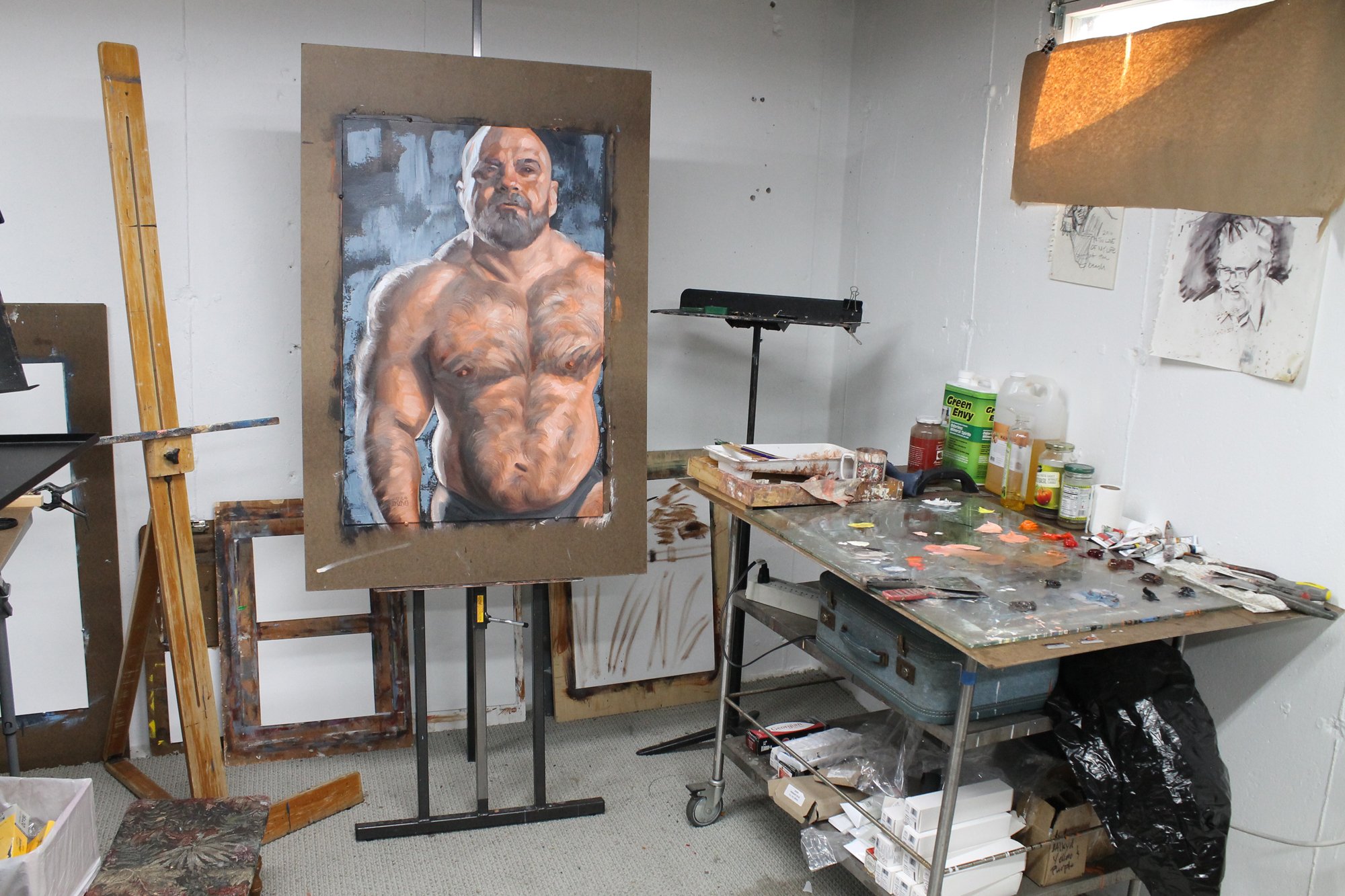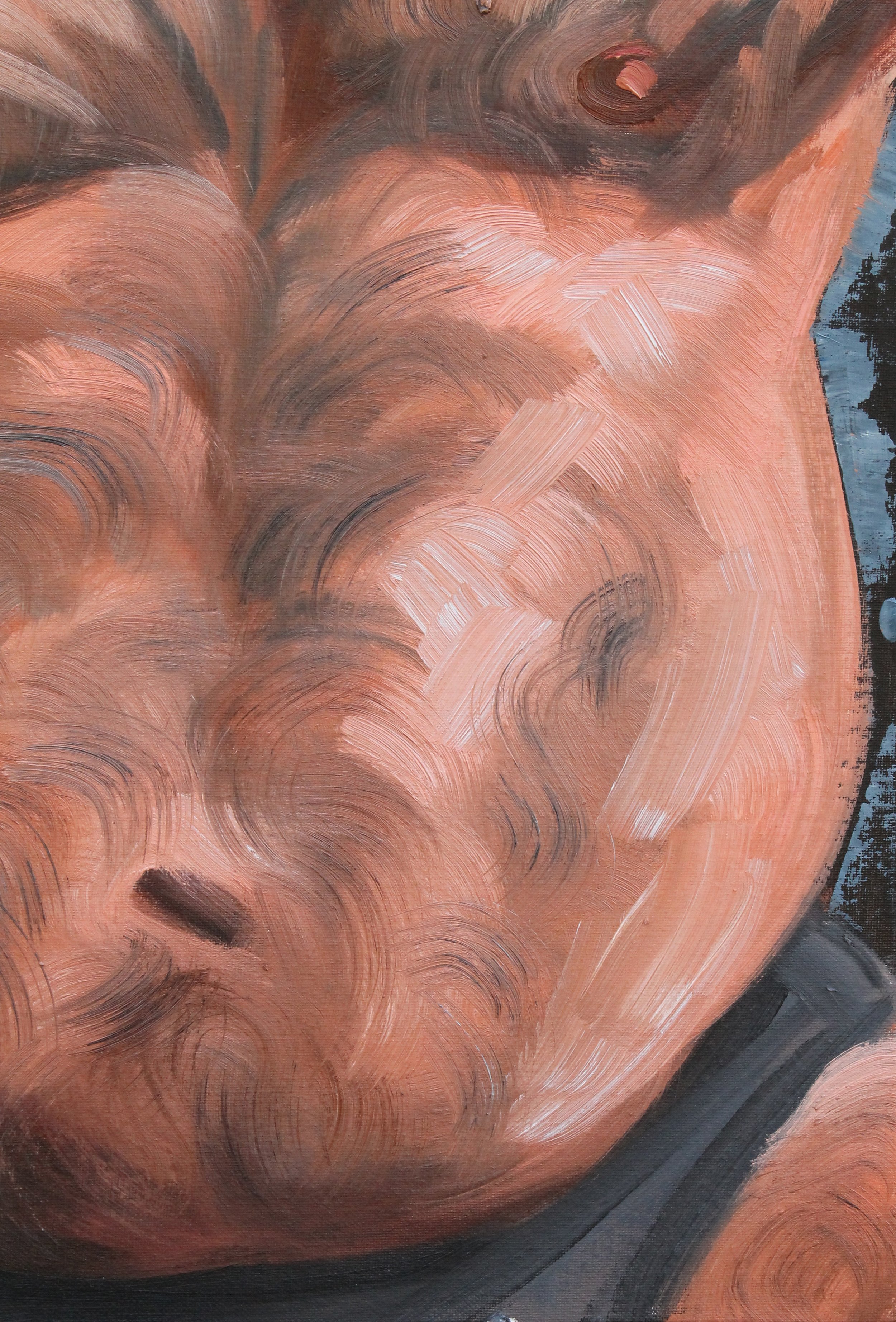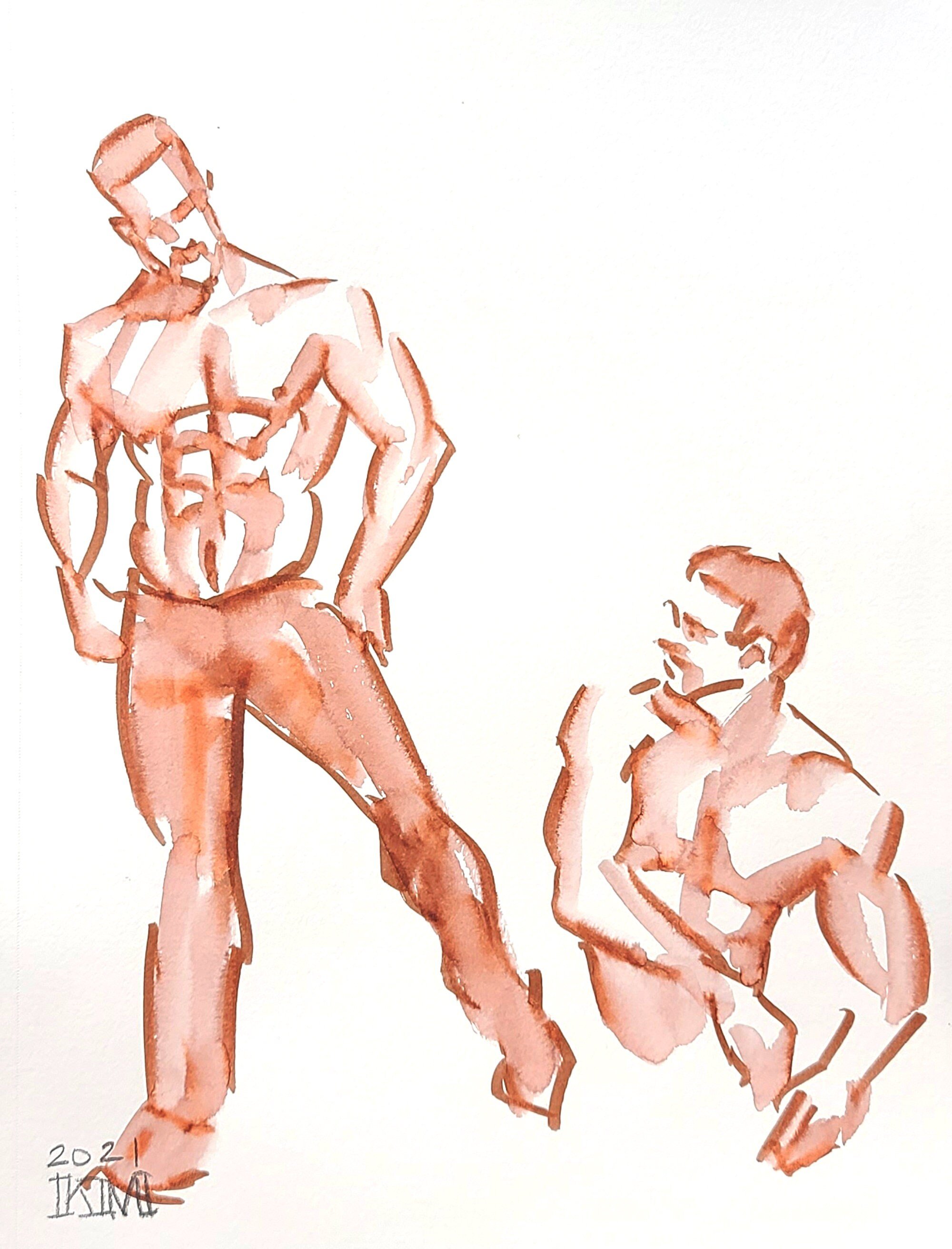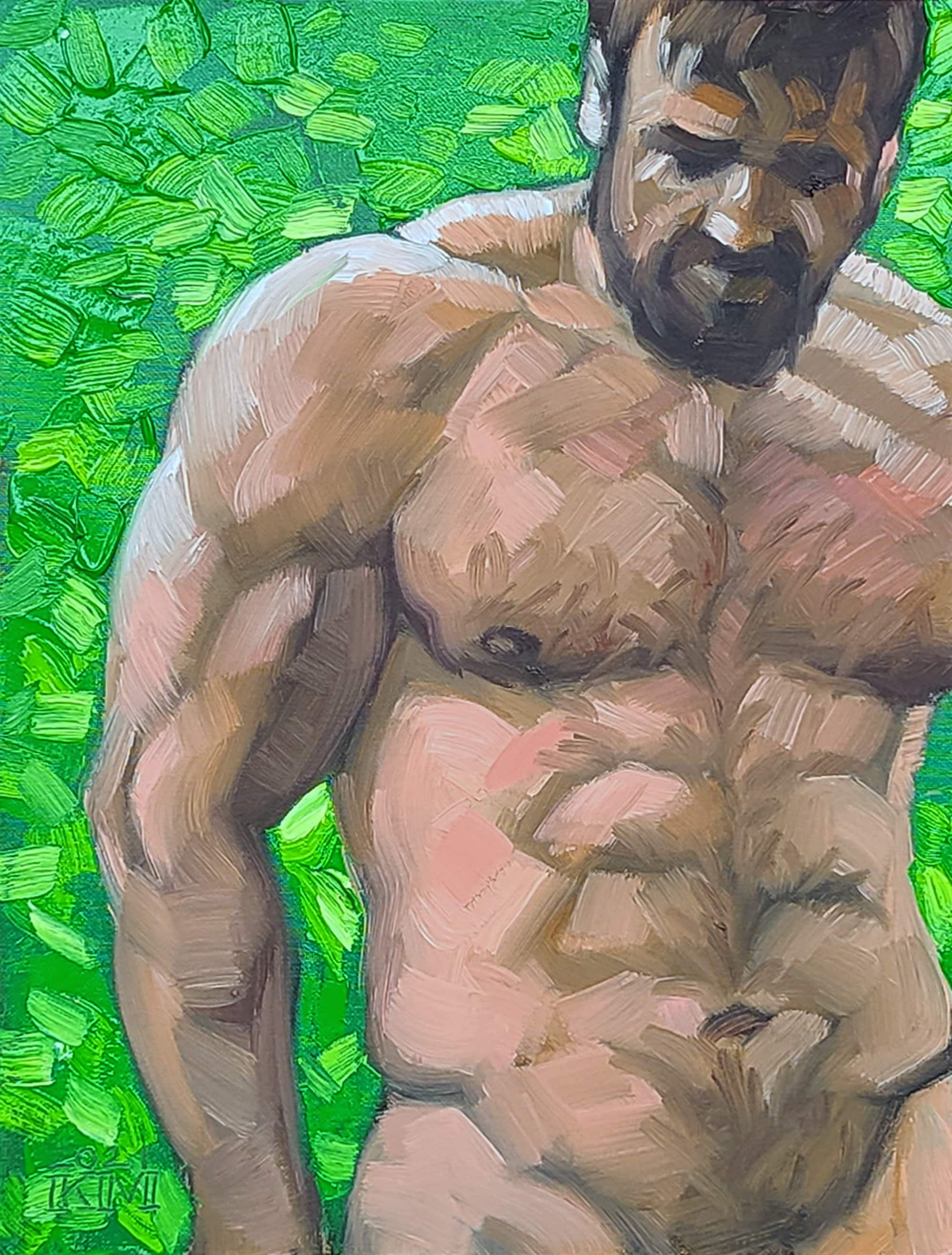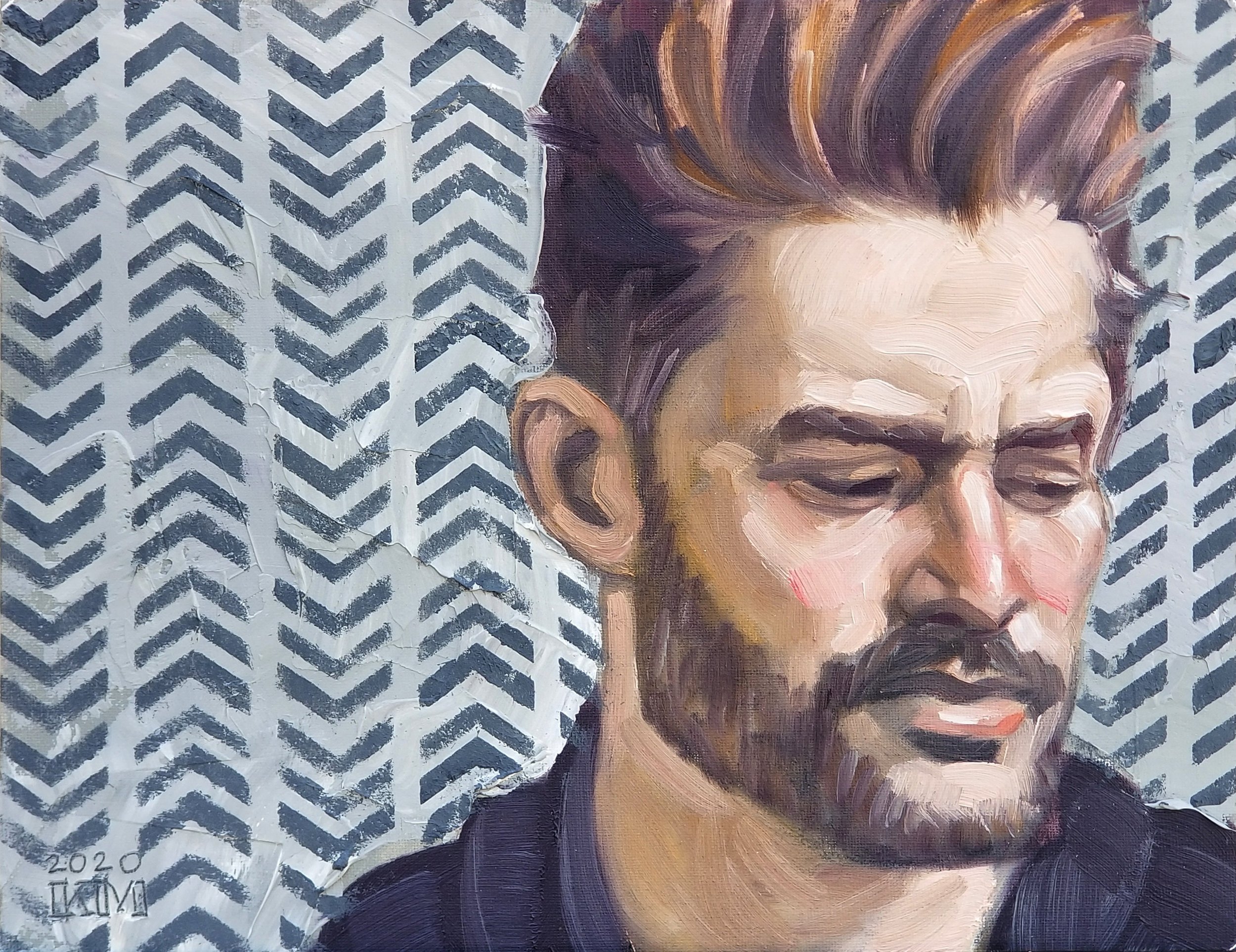Volunteer, 24x36 inches oil on canvas panel by Kenney Mencher A body positive painting depicting a heavy masculine bear.
FREE SHIPPING
This is an original work of art NOT a print
Shipping takes 4-7 Weeks
I don’t usually let myself make too many large paintings because they are often too expensive and maybe even too large for my collectors, but they are so much fun to make and I always imagine how they might look in a museum! A big painting holds a wall, makes a statement and there is so much more room for me to experiment with texture, layering, and color. I made a version of this painting last year and it was 18 by 24 inches. Since that time, the painting sold. I missed it and wanted to try making a larger version. In a way, the smaller older version, is a kind of rehearsal or study for this large painting.
This painting took a couple of weeks to complete. My working method is that I will often spend a couple of days sketching out or drawing compositions on anywhere between three to 10 canvases with a crayon to try to get the underdrawing correct and work on the compositions. Sometimes these underdrawings are actually very detailed and I’ll even shade them and make marks on them to give myself a sense of of the direction of the brush marks. One of the things I really like to do is draw and so this satisfies my need to make a study for the painting. I also sometimes make detailed crayon drawings on paper in preparation for these kinds of paintings. The next step is to put down a fairly thick painting on the canvas that I know that I will paint over in later days. This often takes an additional day.
After letting the painting dry for several days, often even letting it sit for a week or two, I’ll return to the painting and start by mixing up large batches of thick, gooey, pasty, paint. I don’t like to thin down the paint because I want the textures to mimic the direction of the planes and contours of the skin and muscles of the figures. I like to use thick hog’s hair bristles brushes to make the painting because then you can really see the brushwork. I vary the textures by sometimes using sable brushes and I’ll even use plastering knives and palette knives to continue to sculpt or apply the paint. If you look at the painting up close you’ll see that the skin and the hair have distinctly different textures as does the background.
This painting also is important to me because it allows me to express my feelings about body positivity and representing people who often are at the very least, not represented by mainstream culture in a positive way, and also not seen as being beautiful. It’s very clear to me that there are a lot of people who find this kind of body type attractive or beautiful. I certainly do and that’s why I like to paint them.
Many straight folks are unaware of the bear subculture. Hardly a surprise, since a powerful majority rarely concerns itself with the doings of a marginalized minority. When, three or four years ago, I first mentioned bears to my straight friends, none of them knew what I was talking about, though by now at least one of them calls me “The Bear.” Similarly, my heterosexual students, as expert as they might be on current media, seem equally ignorant about this topic.
Most GLBT folks, however, by now seem to know the basics. A “bear” is a hairy, bearded, brawny-to-bulky gay man, usually displaying aspects of traditional masculinity. A cub is a younger version of the same; a wolf is a lean, hairy man; an otter a young version of that. “Woof!” is a lustful expression, meaning essentially: “Tasty! I’d like to climb all over that!” “Grrrrr!” means much the same. As you can see, after twenty-some years of development, the bear community, like any subculture, has its own jargon, sometimes called “bearspeak” or “vocabulary.” It also has its own values, its own style, and its own commodities. There are bear-oriented bars, festivals, music, movies, magazines, and books. There are regional clubs for bears not only in metropolitan centers, where the communities first developed, but also in rural areas.
This is on canvas panel which is sturdy and strong. The core is acid free or archival cardboard so it will last for hundreds of years. When you frame this painting, you don’t need to go to a framer since they are very expensive, you could easily buy an open back frame from a website like Dickblick.com or Amazon or Etsy since this is a standard size frame.
FREE SHIPPING
This is an original work of art NOT a print
Shipping takes 4-7 Weeks
I don’t usually let myself make too many large paintings because they are often too expensive and maybe even too large for my collectors, but they are so much fun to make and I always imagine how they might look in a museum! A big painting holds a wall, makes a statement and there is so much more room for me to experiment with texture, layering, and color. I made a version of this painting last year and it was 18 by 24 inches. Since that time, the painting sold. I missed it and wanted to try making a larger version. In a way, the smaller older version, is a kind of rehearsal or study for this large painting.
This painting took a couple of weeks to complete. My working method is that I will often spend a couple of days sketching out or drawing compositions on anywhere between three to 10 canvases with a crayon to try to get the underdrawing correct and work on the compositions. Sometimes these underdrawings are actually very detailed and I’ll even shade them and make marks on them to give myself a sense of of the direction of the brush marks. One of the things I really like to do is draw and so this satisfies my need to make a study for the painting. I also sometimes make detailed crayon drawings on paper in preparation for these kinds of paintings. The next step is to put down a fairly thick painting on the canvas that I know that I will paint over in later days. This often takes an additional day.
After letting the painting dry for several days, often even letting it sit for a week or two, I’ll return to the painting and start by mixing up large batches of thick, gooey, pasty, paint. I don’t like to thin down the paint because I want the textures to mimic the direction of the planes and contours of the skin and muscles of the figures. I like to use thick hog’s hair bristles brushes to make the painting because then you can really see the brushwork. I vary the textures by sometimes using sable brushes and I’ll even use plastering knives and palette knives to continue to sculpt or apply the paint. If you look at the painting up close you’ll see that the skin and the hair have distinctly different textures as does the background.
This painting also is important to me because it allows me to express my feelings about body positivity and representing people who often are at the very least, not represented by mainstream culture in a positive way, and also not seen as being beautiful. It’s very clear to me that there are a lot of people who find this kind of body type attractive or beautiful. I certainly do and that’s why I like to paint them.
Many straight folks are unaware of the bear subculture. Hardly a surprise, since a powerful majority rarely concerns itself with the doings of a marginalized minority. When, three or four years ago, I first mentioned bears to my straight friends, none of them knew what I was talking about, though by now at least one of them calls me “The Bear.” Similarly, my heterosexual students, as expert as they might be on current media, seem equally ignorant about this topic.
Most GLBT folks, however, by now seem to know the basics. A “bear” is a hairy, bearded, brawny-to-bulky gay man, usually displaying aspects of traditional masculinity. A cub is a younger version of the same; a wolf is a lean, hairy man; an otter a young version of that. “Woof!” is a lustful expression, meaning essentially: “Tasty! I’d like to climb all over that!” “Grrrrr!” means much the same. As you can see, after twenty-some years of development, the bear community, like any subculture, has its own jargon, sometimes called “bearspeak” or “vocabulary.” It also has its own values, its own style, and its own commodities. There are bear-oriented bars, festivals, music, movies, magazines, and books. There are regional clubs for bears not only in metropolitan centers, where the communities first developed, but also in rural areas.
This is on canvas panel which is sturdy and strong. The core is acid free or archival cardboard so it will last for hundreds of years. When you frame this painting, you don’t need to go to a framer since they are very expensive, you could easily buy an open back frame from a website like Dickblick.com or Amazon or Etsy since this is a standard size frame.
FREE SHIPPING
This is an original work of art NOT a print
Shipping takes 4-7 Weeks
I don’t usually let myself make too many large paintings because they are often too expensive and maybe even too large for my collectors, but they are so much fun to make and I always imagine how they might look in a museum! A big painting holds a wall, makes a statement and there is so much more room for me to experiment with texture, layering, and color. I made a version of this painting last year and it was 18 by 24 inches. Since that time, the painting sold. I missed it and wanted to try making a larger version. In a way, the smaller older version, is a kind of rehearsal or study for this large painting.
This painting took a couple of weeks to complete. My working method is that I will often spend a couple of days sketching out or drawing compositions on anywhere between three to 10 canvases with a crayon to try to get the underdrawing correct and work on the compositions. Sometimes these underdrawings are actually very detailed and I’ll even shade them and make marks on them to give myself a sense of of the direction of the brush marks. One of the things I really like to do is draw and so this satisfies my need to make a study for the painting. I also sometimes make detailed crayon drawings on paper in preparation for these kinds of paintings. The next step is to put down a fairly thick painting on the canvas that I know that I will paint over in later days. This often takes an additional day.
After letting the painting dry for several days, often even letting it sit for a week or two, I’ll return to the painting and start by mixing up large batches of thick, gooey, pasty, paint. I don’t like to thin down the paint because I want the textures to mimic the direction of the planes and contours of the skin and muscles of the figures. I like to use thick hog’s hair bristles brushes to make the painting because then you can really see the brushwork. I vary the textures by sometimes using sable brushes and I’ll even use plastering knives and palette knives to continue to sculpt or apply the paint. If you look at the painting up close you’ll see that the skin and the hair have distinctly different textures as does the background.
This painting also is important to me because it allows me to express my feelings about body positivity and representing people who often are at the very least, not represented by mainstream culture in a positive way, and also not seen as being beautiful. It’s very clear to me that there are a lot of people who find this kind of body type attractive or beautiful. I certainly do and that’s why I like to paint them.
Many straight folks are unaware of the bear subculture. Hardly a surprise, since a powerful majority rarely concerns itself with the doings of a marginalized minority. When, three or four years ago, I first mentioned bears to my straight friends, none of them knew what I was talking about, though by now at least one of them calls me “The Bear.” Similarly, my heterosexual students, as expert as they might be on current media, seem equally ignorant about this topic.
Most GLBT folks, however, by now seem to know the basics. A “bear” is a hairy, bearded, brawny-to-bulky gay man, usually displaying aspects of traditional masculinity. A cub is a younger version of the same; a wolf is a lean, hairy man; an otter a young version of that. “Woof!” is a lustful expression, meaning essentially: “Tasty! I’d like to climb all over that!” “Grrrrr!” means much the same. As you can see, after twenty-some years of development, the bear community, like any subculture, has its own jargon, sometimes called “bearspeak” or “vocabulary.” It also has its own values, its own style, and its own commodities. There are bear-oriented bars, festivals, music, movies, magazines, and books. There are regional clubs for bears not only in metropolitan centers, where the communities first developed, but also in rural areas.
This is on canvas panel which is sturdy and strong. The core is acid free or archival cardboard so it will last for hundreds of years. When you frame this painting, you don’t need to go to a framer since they are very expensive, you could easily buy an open back frame from a website like Dickblick.com or Amazon or Etsy since this is a standard size frame.




